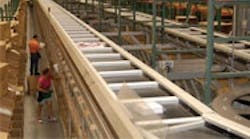When you’re responsible for distributing dreams—hundreds of thousands of dreams— you want to be sure you do it right. That’s the day-to-day business of David’s Bridal. This national retailer of virtually everything to do with weddings (you add your own potential spouse) currently supplies 275 retail outlets from its two distribution centers in eastern Pennsylvania. The newer center is located in Bristol, just north of Philadelphia. Its unpretentious building houses more than 150,000 square feet of everything the bride, and her bridesmaids, need—from shoes to tiaras, ribbons to cake cutters.
About three years ago, Tony Coccerino, Jr., director of operations, and other company managers, knew their business was at a crossroads. It needed a guide to point them in the right direction. The guide turned out to be Bryan Jensen, vice president, St. Onge Co., York, Pa.
When to Ask for Help
Jensen metaphorically describes when a company should seek out a project manager, or third-party assistance: You don’t call a lawyer if you don’t need a lawyer—and when you do need a lawyer, you don’t rush off to law school to begin studying.
“The same applies to material handling,” he says. “Our business is to bring to the client a level of expertise he either does not have available when looking at technical aspects of a system, or, does not have time to dedicate to project management.”
The latter was the case with David’s Bridal and Tony Coccerino. “I have a business to run,” says Coccerino. “We looked at the potential growth in our business and assigned a network analysis team to review the options.”
That’s when they turned to the experts from St. Onge who began working on a master plan—Phase I.
He adds that the plan Jensen and his team developed far exceeded what he, Coccerino, had imagined. “It essentially changed the way we do business. In the end, we were able to cut about a day and a half from our time-tomarket and reduce costs all along the line.” That’s the kind of help people look for when they hire a project manager.
Jensen says, while most projects follow similar paths, no two are alike. Phase I, or the design phase, is alternative driven. “Any insight [for how it does business] you bring to the client,” says Jensen, “has to improve upon what they are already doing, especially if they’re already doing it well.”
In this case, the big idea from Phase I was to essentially split the company’s business into two parts. Its existing facility, in Conshohocken, was distributing garments on hangers (GOH) as well as flats, or merchandise in cartons. The optimal design called for converting the Conshohocken operations to distribute GOH exclusively, and start a new facility for distribution of flats. With the major hurdle of what to do cleared, Jensen and his team, which varied in number depending on the phase of the project, helped the client with the next step—identify Bristol as the right location for this new part of the business.
Making the Right Choice
There are plenty of ways to distribute cartons from a distribution center to retail stores. “In this instance, we gave the client four options for distributing its product,” says Jensen. “Because those options are alternative driven, it [the client] can see the impact if it puts less money here, it will have to put more money there. These are all values—the realities of going for the longer time for payback versus instant gratification, for example.” Jensen says clients also have certain predispositions toward a brand or technology so having alternatives based on data—hard values—helps to take any “emotion” out of the equation.
And getting the data to generate those alternatives is not always the easiest of tasks, he says. “Most companies have the information we need to create the scenarios; the challenge comes in extracting the data.”
Typically, companies are collecting a lot of information related to SKUs, and not enough about dimensions and weights. More often than not, the critical factor in determining the core part of a material handling system will depend on the size of the units to be moved.
To get all the right numbers, Jensen and his team spent a lot of hours on the floor at the existing facility in Conshohocken. They watched what employees did and asked why it was done that way. “You have to learn the process,” says Jensen, “because you don’t want to design a plan that precludes them from doing their job as it exists now if they’re efficient at it.”



